sensor CITROEN NEMO 2014 Handbook (in English)
[x] Cancel search | Manufacturer: CITROEN, Model Year: 2014, Model line: NEMO, Model: CITROEN NEMO 2014Pages: 192, PDF Size: 10.74 MB
Page 4 of 192
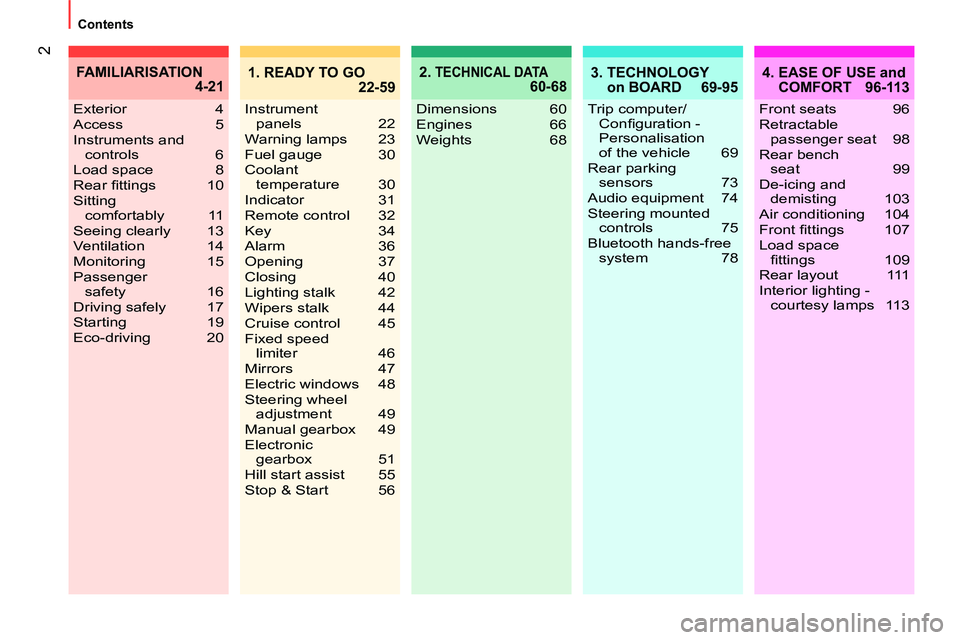
2
Contents
2. TECHNICAL DATA 60-684. EASE OF USE and
COMFORT 96-113
Dimensions 60
Engines 66
Weights 68 Exterior 4
Access 5
Instruments and
controls 6
Load space 8
Rear fi ttings 10
Sitting
comfortably 11
Seeing clearly 13
Ventilation 14
Monitoring 15
Passenger
safety 16
Driving safely 17
Starting 19
Eco-driving 20
FAMILIARISATION
4-21
Front seats 96
Retractable
passenger seat 98
Rear bench
seat 99
De-icing and
demisting 103
Air conditioning 104
Front fi ttings 107
Load space
fi ttings 109
Rear layout 111
Interior lighting -
courtesy lamps 113
3. TECHNOLOGY
on BOARD 69-95
Trip computer/
Confi guration -
Personalisation
of the vehicle 69
Rear parking
sensors 73
Audio equipment 74
Steering mounted
controls 75
Bluetooth hands-free
system 78
1. READY TO GO
22-59
Instrument
panels 22
Warning lamps 23
Fuel gauge 30
Coolant
temperature 30
Indicator 31
Remote control 32
Key 34
Alarm 36
Opening 37
Closing 40
Lighting stalk 42
Wipers stalk 44
Cruise control 45
Fixed speed
limiter 46
Mirrors 47
Electric windows 48
Steering wheel
adjustment 49
Manual gearbox 49
Electronic
gearbox 51
Hill start assist 55
Stop & Start 56
Page 6 of 192
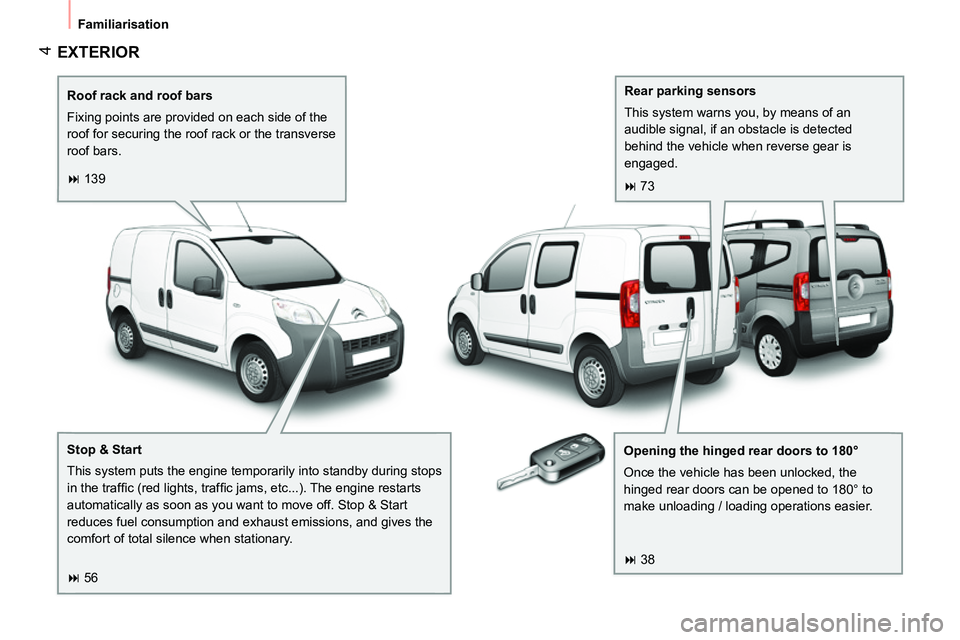
4
Familiarisation
EXTERIOR
Roof rack and roof bars
Fixing points are provided on each side of the
roof for securing the roof rack or the transverse
roof bars.
Opening the hinged rear doors to 180°
Once the vehicle has been unlocked, the
hinged rear doors can be opened to 180° to
make unloading / loading operations easier.
Rear parking sensors
This system warns you, by means of an
audible signal, if an obstacle is detected
behind the vehicle when reverse gear is
engaged.
Stop & Start
This system puts the engine temporarily into standby during stops
in the traffi c (red lights, traffi c jams, etc...). The engine restarts
automatically as soon as you want to move off. Stop & Start
reduces fuel consumption and exhaust emissions, and gives the
comfort of total silence when stationary. 139
56 73
38
Page 30 of 192
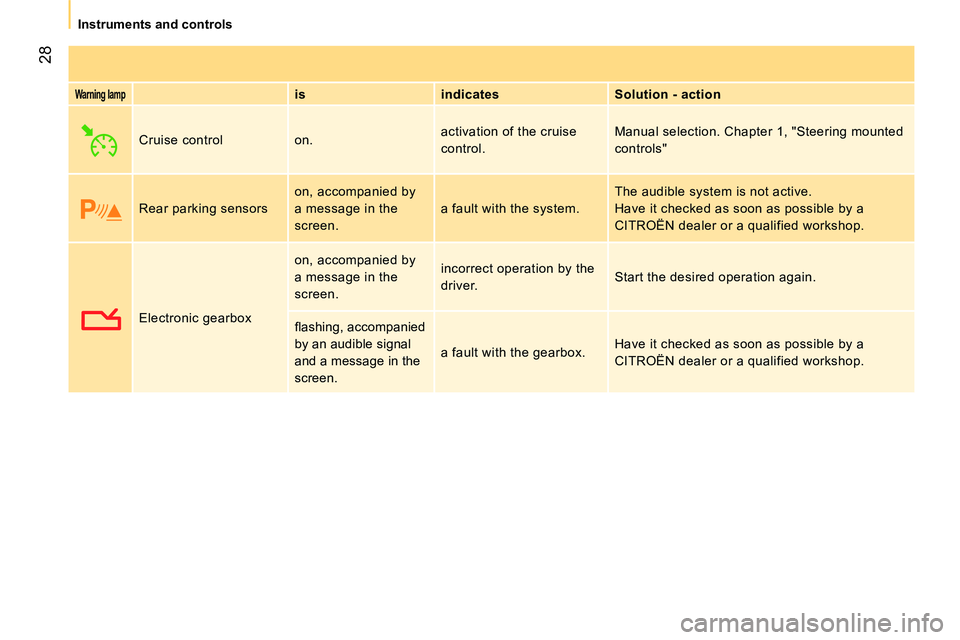
28
Instruments and controls
Warning lamp
is
indicates
Solution - action
Cruise control on. activation of the cruise
control. Manual selection. Chapter 1, "Steering mounted
controls"
Rear parking sensors on, accompanied by
a message in the
screen. a fault with the system. The audible system is not active.
Have it checked as soon as possible by a
CITROËN dealer or a qualified workshop.
Electronic gearbox on, accompanied by
a message in the
screen. incorrect operation by the
driver. Start the desired operation again.
fl ashing, accompanied
by an audible signal
and a message in the
screen. a fault with the gearbox. Have it checked as soon as possible by a
CITROËN dealer or a qualified workshop.
Page 32 of 192
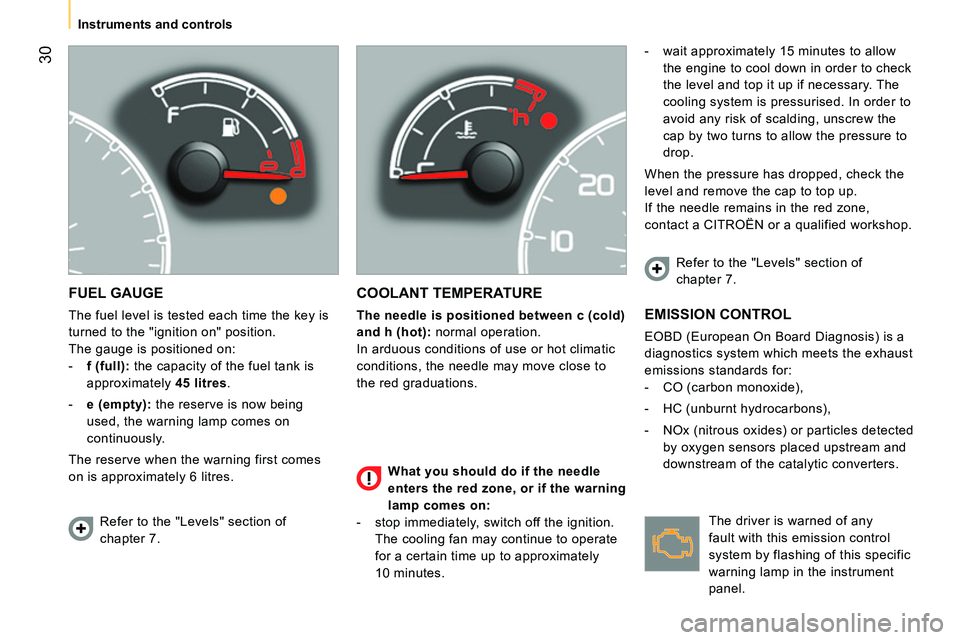
30
Instruments and controls
FUEL GAUGE
The fuel level is tested each time the key is
turned to the "ignition on" position.
The gauge is positioned on:
- f
(full):
the capacity of the fuel tank is
approximately 45 litres
.
- e
(empty):
the reserve is now being
used, the warning lamp comes on
continuously.
The reserve when the warning first comes
on is approximately 6 litres.
COOLANT TEMPERATURE
The needle is positioned between
c
(cold)
and
h
(hot):
normal operation.
In arduous conditions of use or hot climatic
conditions, the needle may move close to
the red graduations.
- wait approximately 15 minutes to allow
the engine to cool down in order to check
the level and top it up if necessary. The
cooling system is pressurised. In order to
avoid any risk of scalding, unscrew the
cap by two turns to allow the pressure to
drop.
When the pressure has dropped, check the
level and remove the cap to top up.
If the needle remains in the red zone,
contact a CITROËN or a qualified workshop. EMISSION CONTROL
EOBD (European On Board Diagnosis) is a
diagnostics system which meets the exhaust
emissions standards for:
- CO (carbon monoxide),
- HC (unburnt hydrocarbons),
- NOx (nitrous oxides) or particles detected
by oxygen sensors placed upstream and
downstream of the catalytic converters.
Refer to the "Levels" section of
chapter 7. Refer to the "Levels" section of
chapter 7.
The driver is warned of any
fault with this emission control
system by flashing of this specific
warning lamp in the instrument
panel.
What you should do if the needle
enters the red zone, or if the warning
lamp comes on:
- stop immediately, switch off the ignition.
The cooling fan may continue to operate
for a certain time up to approximately
10 minutes.
Page 51 of 192

49
1
READY TO GO
Gearbox and steering wheel
Good practice
To change gear smoothly, always press the
clutch pedal fully down.
To prevent the mat from becoming caught under the pedal:
- ensure that the mat is positioned correctly,
- never fit one mat on top of another.
Avoid leaving your hand on the gear knob as
the force exerted, even if slight, may cause
wear of the internal components of the
gearbox over time.
MANUAL GEARBOX
Reverse gear
Never engage reverse gear until the vehicle
is completely stationary.
The lever should be moved slowly to reduce
the noise on engaging reverse gear.
If your vehicle is fitted with parking
sensors, the system comes into
operation when reverse gear is engaged,
confirmed by an audible signal.
Refer to the "Rear parking sensors"
section of chapter 3.
STEERING WHEEL ADJUSTMENT
When the vehicle is stationary, release the
steering wheel adjustment by pushing the
lever down.
Adjust the steering wheel for height and
reach, then lock by pulling the lever up fully.
Page 75 of 192

73
3
TECHNOLOGY on BOARD
Parking sensors
REAR PARKING SENSORS
The audible system consists of four
proximity sensors, fitted in the rear bumper.
It detects any obstacle which comes within
range: person, vehicle, tree, fence, behind
the vehicle during the manoeuvre.
However, it will not be able to detect
obstacles located immediately below the
bumper.
An object, such as a stake, a roadworks
cone or any other similar object may be
detected at the beginning of the manoeuvre
but may no longer be detected when the
vehicle moves close to it.
This system does not take the place of the
vigilance and responsibility of the driver.
Stop the assistance
Change to neutral.
Operating fault
If this warning lamp or the service
warning lamp comes on in the
instrument panel, accompanied
by a message in the screen,
contact a CITROËN dealer or a
qualified workshop.
Good practice
In bad weather or in winter, ensure that the
sensors are not covered with mud, ice or
snow.
Engage reverse gear
The proximity information is indicated by an
audible signal which becomes more frequent
as the vehicle approaches the obstacle.
When the distance between the rear of
the vehicle and the obstacle is less than
approximately thirty centimetres, the audible
signal becomes continuous.
This function will be deactivated
automatically if a trailer is being towed.
You are advised to obtain a towbar
recommended by CITROËN and have it
installed by a professional.
If anomalies are detected on engaging
reverse gear, the warning lamp comes on,
possibly accompanied by a message in the
screen.
73
Page 115 of 192

11 3
4
EASE OF USE and COMFORT
Practical information
INTERIOR LIGHTING
Front courtesy lamp
This is located in the centre of the roof.
It is switched on by:
- tilting the lens,
- opening or closing a door,
- locking or unlocking the vehicle.
It switches off automatically, after a few
minutes, if the doors remain open, or when
the ignition is switched on.
The courtesy lamp unit may be fitted with an
alarm sensor, a microphone for the hands-
free kit and reading lamps.
The reading lamps have right-hand and
left-hand switches.
Rear courtesy lamp
This is located on the upper part of the rear
right side.
Press the side of the courtesy lamp lens to
switch it on or off.
It comes on automatically when a door is
opened (Combi).
It comes on automatically when opening
a sliding side door or the side-hinged rear
doors (light vans).
Good practice
It switches off automatically:
- if the switch is not pressed down,
- in all cases within approximately
15 minutes if the doors remain open,
- on closing the doors, after a timed period,
- when the ignition is switched on,
- when locking.
Boot lamp
This is located in the centre of the torch
base.
The lamp operates in accordance with the
three positions of the switch below.
Permanently on.
In this "AUTO"
position, it comes
on gradually when the vehicle is
unlocked and when a rear door or
the tailgate is opened.
It switches off automatically, after a few
minutes, if a rear door or the tailgate
remains open, or when the ignition is
switched on.
Permanently off.
When closing the doors, the time
before the front and rear courtesy
lamps go out may not be same.
Page 140 of 192

138
Towing a trailer
In certain cases of particularly arduous
use (towing the maximum load up a steep
slope in high temperatures), the engine
automatically limits its power. In this case,
automatic cutting off of the air conditioning
allows the engine power to be saved.
If the coolant temperature
warning lamp comes on, stop the
vehicle and switch off the engine
as soon as possible.
See the "Levels" section of chapter 7.
Tyres:
check the tyre pressures of the
towing vehicle (see the "Identification
markings" section of chapter 7) and of
the trailer, observing the recommended
pressures.
Brakes:
towing increases the braking
distance. Drive at a moderate speed,
change down early and brake gradually.
Side wind:
sensitivity to side wind is
increased. Drive smoothly and at a
moderate speed.
ABS:
the system only controls the vehicle,
not the trailer.
Rear parking sensors:
the sensors
will be deactivated automatically
when an genuine CITROËN towbar is used
(see the "Rear parking sensors" section of
chapter 3).
Towbar
We recommend the use of genuine
CITROËN towbars and their harnesses,
which have been tested and approved from
the design stage of your vehicle, and that
the fitting of this equipment is entrusted to a
CITROËN dealer or a qualified workshop.
If this equipment is not fitted by a CITROËN
dealer, it is essential that it is fitted using
the electrical pre-equipment located at
the rear of the vehicle and following the
manufacturer's instructions.
The operation of the rear parking sensors is
deactivated automatically when the trailer
cable connector is inserted in the towbar
socket.
When the trailer cable is removed, the rear
parking sensors are re-activated.
Distribution of loads
Distribute the load in the trailer so that the
heaviest objects are as close as possible
to the axle and the nose weight is close to
the maximum authorised without, however,
exceeding it. The air density decreases with
altitude, so reducing the performance of
the engine. The maximum towed load must
be reduced by 10 % for each 1 000 metres
of altitude. Refer to the "Technical data"
chapter for details of the weights and
towed loads applicable to your vehicle
and also to the administrative documents
(V5 registration document, ...).
Page 142 of 192
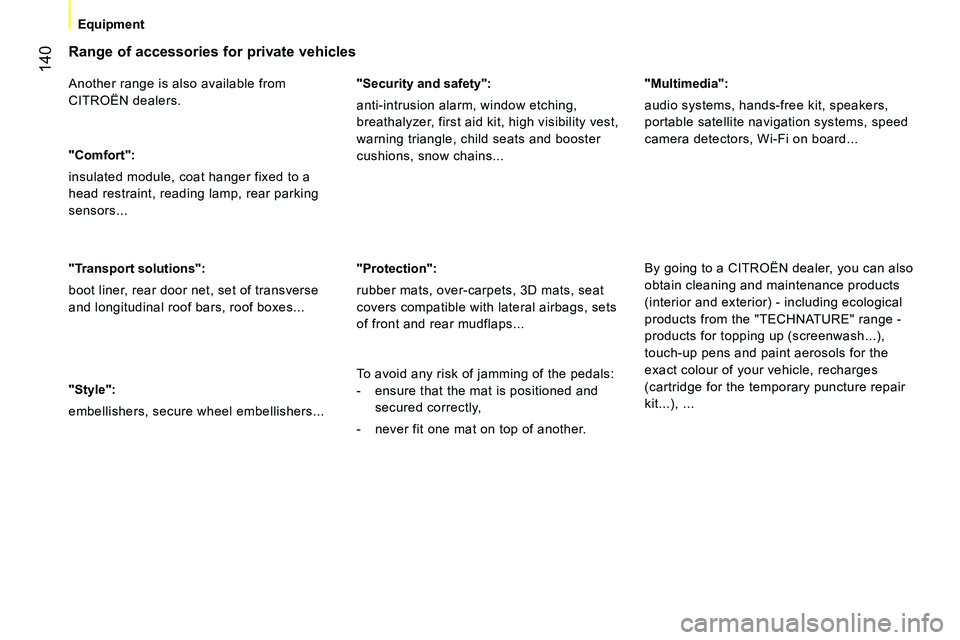
140
Equipment
Range of accessories for private vehicles
Another range is also available from
CITROËN dealers.
"Comfort":
insulated module, coat hanger fixed to a
head restraint, reading lamp, rear parking
sensors...
"Transport solutions":
boot liner, rear door net, set of transverse
and longitudinal roof bars, roof boxes...
"Style":
embellishers, secure wheel embellishers...
"Security and safety":
anti-intrusion alarm, window etching,
breathalyzer, first aid kit, high visibility vest,
warning triangle, child seats and booster
cushions, snow chains...
"Protection":
rubber mats, over-carpets, 3D mats, seat
covers compatible with lateral airbags, sets
of front and rear mudflaps...
"Multimedia":
audio systems, hands-free kit, speakers,
portable satellite navigation systems, speed
camera detectors, Wi-Fi on board...
By going to a CITROËN dealer, you can also
obtain cleaning and maintenance products
(interior and exterior) - including ecological
products from the "TECHNATURE" range -
products for topping up (screenwash...),
touch-up pens and paint aerosols for the
exact colour of your vehicle, recharges
(cartridge for the temporary puncture repair
kit...), ...
To avoid any risk of jamming of the pedals:
- ensure that the mat is positioned and
secured correctly,
- never fit one mat on top of another.
Page 144 of 192

142
Battery
Models with Stop & Start
A.
Protective cover.
B.
Positive battery terminal on your vehicle.
C.
Slave battery.
D.
Earth point on your vehicle.
E.
Connector release button.
F.
Check sensor connector.
G.
State of charge sensor.
H.
Negative battery terminal on your vehicle.
Charging the battery using a battery charger
- Follow the instructions for use provided
by the battery charger manufacturer.
- Check that the battery posts and
terminals are clean. If they are covered
with sulphate (white or greenish deposit),
disconnect them and clean them.
- Reconnect connector F
of the check
sensor G
.
- Refit the protective cover A
to the
positive battery terminal B
.
Starting using another battery
- Remove the protective cover A
from the
positive battery terminal B
.
- Connect the red cable to positive battery
terminal B
, then to the (+) terminal of the
slave battery C
.
- Connect one end of the green or black
cable to the (-) terminal of the slave
battery C
.
- Connect the other end of the green or
black cable to the earth point D
of your
vehicle (not to the negative battery
terminal H
of your vehicle).
- Operate the starter, let the engine run.
- Wait for the engine to return to idle, then
disconnect the cables.
- Refit the protective cover A
to the
positive battery terminal B
.
Do not disconnect the battery to charge it.
- Press the release button E
to disconnect
the connector F
.
- Disconnect the connector F
from the
check sensor G
.
- Remove the protective cover A
from the
positive battery terminal B
.
- Connect the charger cables: (+) to the
positive battery terminal B
; (-) to the
negative battery terminal H
. Never remove the check sensor G
from the negative battery terminal H
,
except when replacing the battery.